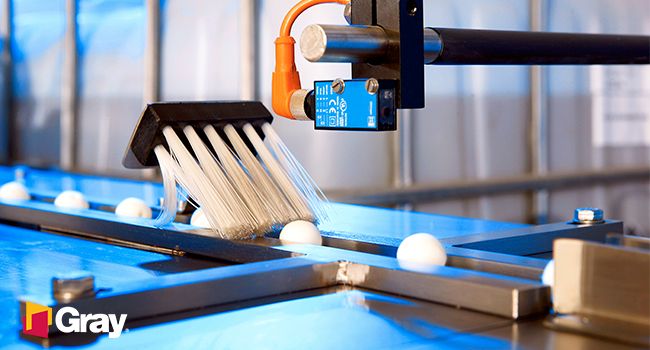Redefining Manufacturing: What It Really Means to Be Makers

Manufacturing’s role in your life is deeper than you think.
What is manufacturing? Once you start thinking about it, it’s very hard to stop. It’s very easy to observe and check off manufactured things in your life – phones, cars, clothes, furniture, etc. This is likely one of the easiest definitions of manufacturing – somebody somewhere took raw materials and built this thing I’m holding right now. Less easy is thinking about the role of technology, materials and engineering that go into designing, processing, assembling, packaging and delivering that thing. It’s been accurately said that there is more technology in the greeting card that plays “Happy Birthday to You” than it took to put a man on the moon. In truth, this barely scratches the surface.
Breaking Manufacturing Down
Is food manufactured? If you buy from a grocery store, it could easily be argued that it is. Produce or other foodstuffs are harvested, processed, assembled, packaged and delivered to a retail outlet. Is your healthcare a manufactured product? Certainly, pharmaceuticals are an example of process manufacturing, and medical devices from cotton swabs to CT scanners are examples of discrete manufacturing – making individual products from individual parts.

In a recent Bloomberg column, “Staying Rich Without Manufacturing Will be Hard,” columnist Noah Smith describes thinking about manufacturing as an economics exercise, which it is. He writes, “There are reasons to think a successful developed nation still needs a healthy manufacturing sector. Harvard University’s Kennedy School of Government economist Ricardo Hausmann believes that a country’s economic development depends crucially on where it lies in the so-called product space. If a country makes complex products that are linked to many other industries – such as computers, cars, and chemicals – it will be rich. But if it makes simple products that don’t have much of a supply chain – soybeans or oil – it will stay poor. In the past, the U.S. was very successful at positioning itself at the top of the global value chain. But with manufacturing’s decline, the rise of finance, real estate, and other orphaned service industries may not be enough to keep the country rich in the long run.”
An Evolving Industry
But manufacturing is turning around, and it is manufacturing technology that continues to play a growing role. In April, the Association for Manufacturing Technology (AMT) reported, “Many key economic indicators are showing strong, positive signs for our industry. The Purchasing Managers’ Index moved up for the sixth consecutive month, suggesting continued expansion of the manufacturing sector. February’s 57.7 is the highest level for the index since August 2014. Another key growth indicator for the manufacturing technology market is the expansion of cutting tool shipments — the consumables that go onto the capital equipment. Monthly cutting tool shipments for the last quarter have posted better numbers than in the same quarter for 2015, pointing to a definitive trend upward in the cutting tool market. And meanwhile, the capacity utilization rate for durable manufacturing grew at an annualized rate of 7.8 percent, thus edging manufacturing closer to a utilization rate that will test older equipment’s durability and require significant demand for new replacement machines and most likely capacity expansion as well.”
It is also thought-provoking to contemplate manufacturing’s relationship throughout the economy and society itself. The National Institute of Standards and Technology (NIST), a unit of the U.S. Department of Commerce, recently published an infographic, “Facts About Manufacturing,” that forces expanded thinking. For example, nearly 60 percent of total U.S. exports can be considered manufactured goods, representing $1.3 trillion. And NIST defines manufacturing as worth $2.2 trillion, or more than 11 percent of the total U.S. gross domestic product (GDP).

But, manufacturing does not exist in a vacuum. Manufacturing is everywhere and is also a lever, lifting entire segments of the economy, as manufacturing jobs create auxiliary employment in retail, health care and other areas, even academia. The NIST infographic identifies research and development (R&D) as a direct beneficiary of manufacturing, with manufacturing accounting for 68 percent of U.S. R&D spending.
Indeed, what will it take to make an autonomous car driving along intelligent roads? Re-usable rocket travel? Water and food processing that can eliminate hunger and famine? Manufacturing jobs are changing. Manufacturing facilities are changing. The more we redefine what it means to make the things we use and consume, the more we redefine economics, education, our relationships with society and the future, and even ourselves. We are a manufacturing people.
- Category:
- Industry
- Manufacturing
Some opinions expressed in this article may be those of a contributing author and not necessarily Gray.
Related News & Insights
Manufacturing, Construction
Nanotechnology and Manufacturing: The Future Is Bright
Industry
Manufacturing
The Critical Connection: How to Interface with Your Manufacturing Equipment
Industry
Manufacturing
Corporate Tax Reform: What It Could Mean for the American Industrial Economy
Industry